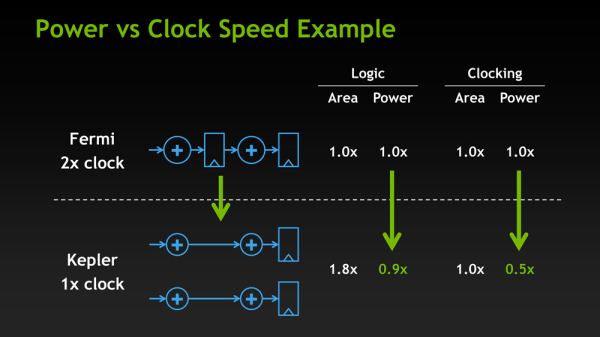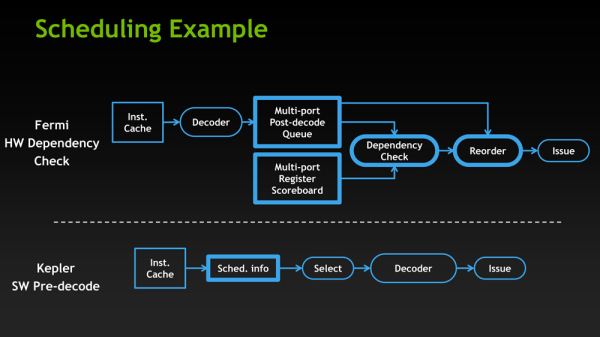NVIDIA GeForce GTX 680 Review: Retaking The Performance Crown
by Ryan Smith on March 22, 2012 9:00 AM ESTThe Kepler Architecture: Efficiency & Scheduling
So far we’ve covered how NVIDIA has improved upon Fermi for; now let’s talk about why.
Mentioned quickly in our introduction, NVIDIA’s big push with Kepler is efficiency. Of course Kepler needs to be faster (it always needs to be faster), but at the same time the market is making a gradual shift towards higher efficiency products. On the desktop side of matters GPUs have more or less reached their limits as far as total power consumption goes, while in the mobile space products such as Ultrabooks demand GPUs that can match the low power consumption and heat dissipation levels these devices were built around. And while strictly speaking NVIDIA’s GPUs haven’t been inefficient, AMD has held an edge on performance per mm2 for quite some time, so there’s clear room for improvement.
In keeping with that ideal, for Kepler NVIDIA has chosen to focus on ways they can improve Fermi’s efficiency. As NVIDIA's VP of GPU Engineering, Jonah Alben puts it, “[we’ve] already built it, now let's build it better.”
There are numerous small changes in Kepler that reflect that goal, but of course the biggest change there was the removal of the shader clock in favor of wider functional units in order to execute a whole warp over a single clock cycle. The rationale for which is actually rather straightforward: a shader clock made sense when clockspeeds were low and die space was at a premium, but now with increasingly small fabrication processes this has flipped. As we have become familiar with in the CPU space over the last decade, higher clockspeeds become increasingly expensive until you reach a point where they’re too expensive – a point where just distributing that clock takes a fair bit of power on its own, not to mention the difficulty and expense of building functional units that will operate at those speeds.
With Kepler the cost of having a shader clock has finally become too much, leading NVIDIA to make the shift to a single clock. By NVIDIA’s own numbers, Kepler’s design shift saves power even if NVIDIA has to operate functional units that are twice as large. 2 Kepler CUDA cores consume 90% of the power of a single Fermi CUDA core, while the reduction in power consumption for the clock itself is far more dramatic, with clock power consumption having been reduced by 50%.
Of course as NVIDIA’s own slide clearly points out, this is a true tradeoff. NVIDIA gains on power efficiency, but they lose on area efficiency as 2 Kepler CUDA cores take up more space than a single Fermi CUDA core even though the individual Kepler CUDA cores are smaller. So how did NVIDIA pay for their new die size penalty?
Obviously 28nm plays a significant part of that, but even then the reduction in feature size from moving to TSMC’s 28nm process is less than 50%; this isn’t enough to pack 1536 CUDA cores into less space than what previously held 384. As it turns out not only did NVIDIA need to work on power efficiency to make Kepler work, but they needed to work on area efficiency. There are a few small design choices that save space, such as using 8 SMXes instead of 16 smaller SMXes, but along with dropping the shader clock NVIDIA made one other change to improve both power and area efficiency: scheduling.
GF114, owing to its heritage as a compute GPU, had a rather complex scheduler. Fermi GPUs not only did basic scheduling in hardware such as register scoreboarding (keeping track of warps waiting on memory accesses and other long latency operations) and choosing the next warp from the pool to execute, but Fermi was also responsible for scheduling instructions within the warps themselves. While hardware scheduling of this nature is not difficult, it is relatively expensive on both a power and area efficiency basis as it requires implementing a complex hardware block to do dependency checking and prevent other types of data hazards. And since GK104 was to have 32 of these complex hardware schedulers, the scheduling system was reevaluated based on area and power efficiency, and eventually stripped down.
The end result is an interesting one, if only because by conventional standards it’s going in reverse. With GK104 NVIDIA is going back to static scheduling. Traditionally, processors have started with static scheduling and then moved to hardware scheduling as both software and hardware complexity has increased. Hardware instruction scheduling allows the processor to schedule instructions in the most efficient manner in real time as conditions permit, as opposed to strictly following the order of the code itself regardless of the code’s efficiency. This in turn improves the performance of the processor.
However based on their own internal research and simulations, in their search for efficiency NVIDIA found that hardware scheduling was consuming a fair bit of power and area for few benefits. In particular, since Kepler’s math pipeline has a fixed latency, hardware scheduling of the instruction inside of a warp was redundant since the compiler already knew the latency of each math instruction it issued. So NVIDIA has replaced Fermi’s complex scheduler with a far simpler scheduler that still uses scoreboarding and other methods for inter-warp scheduling, but moves the scheduling of instructions in a warp into NVIDIA’s compiler. In essence it’s a return to static scheduling.
Ultimately it remains to be seen just what the impact of this move will be. Hardware scheduling makes all the sense in the world for complex compute applications, which is a big reason why Fermi had hardware scheduling in the first place, and for that matter why AMD moved to hardware scheduling with GCN. At the same time however when it comes to graphics workloads even complex shader programs are simple relative to complex compute applications, so it’s not at all clear that this will have a significant impact on graphics performance, and indeed if it did have a significant impact on graphics performance we can’t imagine NVIDIA would go this way.
What is clear at this time though is that NVIDIA is pitching GTX 680 specifically for consumer graphics while downplaying compute, which says a lot right there. Given their call for efficiency and how some of Fermi’s compute capabilities were already stripped for GF114, this does read like an attempt to further strip compute capabilities from their consumer GPUs in order to boost efficiency. Amusingly, whereas AMD seems to have moved closer to Fermi with GCN by adding compute performance, NVIDIA seems to have moved closer to Cayman with Kepler by taking it away.
With that said, in discussing Kepler with NVIDIA’s Jonah Alben, one thing that was made clear is that NVIDIA does consider this the better way to go. They’re pleased with the performance and efficiency they’re getting out of software scheduling, going so far to say that had they known what they know now about software versus hardware scheduling, they would have done Fermi differently. But whether this only applies to consumer GPUs or if it will apply to Big Kepler too remains to be seen.












404 Comments
View All Comments
SlyNine - Thursday, March 22, 2012 - link
While I love BF3, it's not the only game that matters, but it is the only example of the 680 beating the 7970 at frame rates that matter. However the 7970 is catching up as the res goes up. If we add 2 monitors does the 680 still win ?BTW Crysis and Metro 2033 FPS matters to me. Do you think the GPU world revolves around you and what you want? You are not the center of the Videocard world.
Eugene86 - Thursday, March 22, 2012 - link
No, the GPU world doesn't revolve around me but as I already said, nobody but you and a handful of other people actually care about the Crysis and Metro benchmarks because almost nobody plays those games anymore.In my example, Battlefield 3 is a current game that is actually played by people so those benchmarks are useful.
The only reason why Crysis and Metro are used are because they are benchmark games that stress the video cards to their limits. This is nice for bragging rights but completely useless in the real world.
Nvidia and AMD both release video cards that are aimed to please their main market, which is gamers who play on a single monitor at 1080p.
SlyNine - Friday, March 23, 2012 - link
So what are you baseing this on? can you give me any sources?I'm not buying a 600$ video card for just one game.
Plus like I said, as the settings go up, they seem to converge. I can't help but wonder if the 7970 would overtake the 680 at some point before we hit 30fps.
CeriseCogburn - Tuesday, March 27, 2012 - link
Then look at SHOGUN 2 total war in this very article man.Wow, s many of you are so controlled and so mindless on things...
" Total War: Shogun 2 is the latest installment of the long-running Total War series of turn based strategy games, and alongside Civilization V is notable for just how many units it can put on a screen at once. As it also turns out, it’s the single most punishing game in our benchmark suite "
680 takes the top in that game man.
Galidou - Sunday, March 25, 2012 - link
''Nvidia and AMD both release video cards that are aimed to please their main market, which is gamers who play on a single monitor at 1080p''Well then it means that gamers can be more than pleased with a radeon 6870 at 140$ that runs everything with 95% graphical options enabled or a gtx 560ti(not the 448 cores version) for around 200$ which performs a little better than the 6870 and still does the trick in everygame at 1080p.
Prices taken from the bay as no regular 560ti was available on newegg for price comparison.
Oh... and for the 5% graphical options you can't turn on, you'll only notice when you go on a sunday walk in your games, but doing so will have you dead in a second if you play online against other players...
b3nzint - Monday, March 26, 2012 - link
i play metro, cysis a lot, amazing graphic! but thats not "real world" to me. maybe if i play bf3 im in real world?CeriseCogburn - Tuesday, March 27, 2012 - link
Shogun 2 total war, the most demanding game in the benches- did you read ?Nvidia GTX680 sweeps the entire resolution set beating the slower 7970 that cannot handle modern demanding games as well,.
akse - Thursday, March 22, 2012 - link
Seems impossible to do such a feat!!! Considering they launched it months later than the competitor!arjuna1 - Thursday, March 22, 2012 - link
Correct??You call +10 fps difference at best, on certain situations, a domination??
The only good thing this will bring is prices down, the rest is truly unremarkable, for both companies.
See you in the 8xxx/7xxx series.
Wreckage - Thursday, March 22, 2012 - link
Maybe I was a bit hasty. I did forget to mention that it hard launched with working drivers and working h.264 encoding, also quiet under load. Impressive++